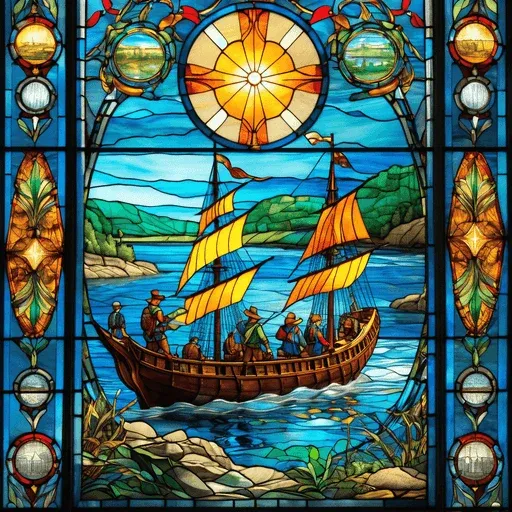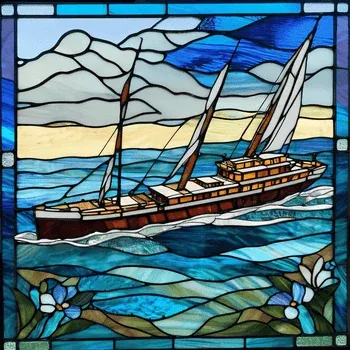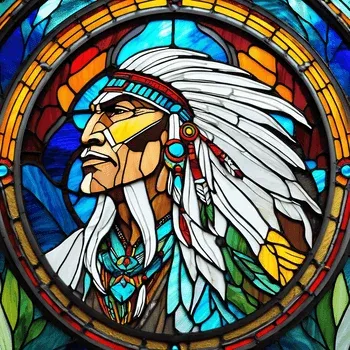There are two great explorers whose names have been made famous by their association with the mighty river of the West, the Mississippi, or Father of Waters,—De Soto, the discoverer, and La Salle, the explorer, of that stupendous stream. Among all the rivers of the earth the Mississippi ranks first. It has its rivals in length and volume, but stands without a rival as a noble channel of commerce, the pride of the West and the glory of the South. We have told the story of its discovery by De Soto, the Spanish adventurer; we have now to tell that of its exploration by La Salle, the French chevalier.
Let us say here that though the honor of exploring the Mississippi has been given to La Salle, he was not the first to traverse its waters. The followers of De Soto descended the stream from the Arkansas to its mouth in 1542. Father Marquette and Joliet, the explorer, descended from the Wisconsin to the Arkansas in 1673. In 1680 Father Hennepin, a Jesuit missionary sent by La Salle, ascended the stream from the Illinois to the Falls of St. Anthony. Thus white men had followed the great river for nearly its whole length. But the greatest of all these explorers and the first to traverse the river for the greater part of its course, was the Chevalier Robert de la Salle, and to his name is given the glory of revealing this grand stream to mankind.
Never was there a more daring and indefatigable explorer than Robert de la Salle. He seemed born to make new lands and new people known to the world. Coming to Canada in 1667, he began his career by engaging in the fur trade on Lake Ontario. But he could not rest while the great interior remained unknown. In 1669 he made an expedition to the west and south, and was the first white man to gaze on the waters of the swift Ohio.
In 1679 he launched on the Great Lakes the first vessel that ever spread its sails on those mighty inland seas, and in this vessel, the Griffin, he sailed through Lakes Erie, Huron, and Michigan.
La Salle next descended the Illinois River, and built a fort where the city of Peoria now stands. But his vessel was wrecked, and he was forced to make his way on foot through a thousand miles of wilderness to obtain supplies at Montreal. Such was the early record of this remarkable man, and for two years afterward his life was full of adventure and misfortune. At length, in 1682, he entered upon the great performance of his life, his famous journey upon the bosom of the Father of Waters.
It was midwinter when La Salle and his men set out from the lakes with their canoes. On the 4th of January, 1682, they reached the mouth of the Chicago River, where its waters enter Lake Michigan. The river was frozen hard, and they had to build sledges to drag their large and heavy canoes down the ice-closed stream. Reaching the portage to the Illinois, they continued their journey across the bleak and snowy waste, toilsomely dragging canoes, baggage, and provisions to the other stream. Here, too, they found a sheet of ice, and for some days longer trudged down the channel of the silent and dreary stream. Its banks had been desolated by Indian wars, and where once many flourishing villages rose there were to be seen only ashes and smoke-blackened ruins.
About the 1st of February they reached Crevecœur, the fort La Salle had built some years earlier. Below this point the stream was free from ice, and after a week's rest the canoes were launched on the liquid surface. They were not long in reaching the point where the Illinois buries its waters in the mighty main river, the grave of so many broad and splendid streams.
Past the point they had now reached the Mississippi poured swiftly downward, its waters swollen, and bearing upon them great sheets of ice, the contribution of the distant north. It was no safe channel for their frail birch-bark canoes, and they were obliged to wait a week till the vast freightage of ice had run past. Then, on the 13th of February, 1682, they launched their canoes on the great stream, and began their famous voyage down its mighty course.
A day's journey brought them to the place where the turbulent Missouri pours its contribution, gathered from thousands of miles of mountain and prairie, into the parent stream, rushing with the force and roar of a rapid through a channel half a mile broad, and quickly converting the clear Mississippi waters into a turbid yellow torrent, thick with mud.
La Salle, like so many of the early explorers, was full of the idea of finding a short route across the continent to the Pacific Ocean, and he found the Indians at the mouth of the Missouri ready to tell him anything he wanted to know. They said that by sailing ten or twelve days up the stream, through populous villages of their people, he would come to a range of mountains in which the river rose; and by climbing to the summit of these lofty hills he could gaze upon a vast and boundless sea, whose waves broke on their farther side. It was one of those imaginative stories which the Indians were always ready to tell, and the whites as ready to believe, and it was well for La Salle that he did not attempt the fanciful adventure.
Savage settlements were numerous along the Mississippi, as De Soto had found a century and more earlier. About thirty miles below the Missouri they came to another village of peaceful natives, whose souls they made happy by a few trifling gifts which were of priceless worth to their untutored minds.
Then downward still they went for a hundred miles or more farther, to the mouth of another great stream, this one flowing from the east, and as noble in its milder way as the Missouri had been in its turbulent flow. Unlike the latter, this stream was gentle in its current, and its waters were of crystal clearness. It was the splendid river which the Indians called the Wabash, or Beautiful River, and the French by the similar name of La Belle Rivière.It is now known as the Ohio, the Indian name being transferred to one of its tributaries. This was the stream on whose waters La Salle had gazed with admiration thirteen years before.
The voyagers were obliged to proceed slowly. Unable to carry many provisions in their crowded canoes, they were often forced to stop and fish or hunt for game.
As the Indians told them they would find no good camping-grounds for many miles below the Ohio,
they stopped for ten days at its mouth,
hunting and gathering supplies.
Parties were sent out to explore in various directions, and one of the men, Peter Prudhomme, failed to return. It was feared that he had been taken captive by the Indians, traces of whom had been seen near by, and a party of Frenchmen, with Indian guides, was sent out on the trails of the natives.
They returned without the lost man, and La Salle, at length, reluctantly giving him up, prepared to continue the journey. Just as they were entering the canoes the missing man reappeared. For nine days he had been lost in the forest, vainly seeking his friends, and wandering hopelessly. His gun, however, had provided him with food, and he reached the stream just in time.
Once more the expedition was launched on the swift-flowing current, eight or ten large birch canoes filled with Indians and Frenchmen in Indian garb, and laden with supplies. The waters bore them swiftly onward, there was little labor with the paddles, the wintry weather was passing and the air growing mild, the sky sunny, and the light-hearted sons of France enjoyed their daily journey through new and strange scenes with the warmest zest.
About one hundred and twenty miles below the Ohio they reached the vicinity of the Arkansas River, the point near which the voyage of Marquette had ended and that of the followers of De Soto began. Here, for the first time in their journey, they met with hostile Indians.
As the flotilla glided on past the Arkansas bluffs, on the 3rd of March, its people were startled by hearing the yells of a large body of savages and the loud sound of a drum, coming from behind the bluff. The natives had taken the alarm, supposing that a war party of their enemies was coming to attack them.
La Salle ordered his canoes at once to be paddled to the other side of the stream, here a mile wide. The party landing, some intrenchments were hastily thrown up, for across the river they could now see a large village, filled with excited and armed warriors. Preparations for defence made, La Salle advanced to the water's edge and made signs of friendship and amity. Pacified by these signals of peace, some of the Indian chiefs rowed across until near the bank, when they stopped and beckoned to the strangers to come to them.
Father Membré, the priest who accompanied the expedition, entered a canoe and was rowed out to the native boat by two Indians. He held out to them the calumet, or pipe of peace, the Indian signal of friendship, and easily induced the chiefs to go with him to the camp of the whites. There were six of them, frank and cordial in manner, and seemingly disposed to friendship. La Salle made them very happy with a few small presents, and at their request the whole party embarked and accompanied them across the river to their village.
All the men of the place crowded to the bank to receive their strange visitors, women and children remaining timidly back. They were escorted to the wigwams, treated with every show of friendship, and regaled with the utmost hospitality. These Arkansas Indians were found to be a handsome race, and very different in disposition from the northern tribes, for they replaced the taciturn and often sullen demeanor of the latter with a gay and frank manner better suited to their warmer clime. They were also much more civilized, being skilled agriculturists, and working their fields by the aid of slaves captured in war. Corn, beans, melons, and a variety of fruits were grown in their fields, and large flocks of turkeys and other fowls were seen round their dwellings.
La Salle and his party stayed in the village for some two weeks, and before leaving went through the form of taking possession of the country in the name of the king of France. This proceeding was conducted with all the ceremony possible under the circumstances, a large cross being planted in the centre of the village, anthems sung, and religious rites performed. The Indians looked on in delight at the spectacle, blankly ignorant of what it all meant, and probably thinking it was got up for their entertainment. Had they known its full significance they might not have been so well pleased.
Embarking again on the 17th of March, the explorers continued their journey down the stream, coming after several days to a place where the river widened into a lake-like expanse. This broad sheet of water was surrounded with villages, forty being counted on the east side and thirty-four on the west. On landing in this populous community, they found the villages to be well built, the houses being constructed of clay mixed with straw, and covered with dome-like roofs of canes. Many convenient articles of furniture were found within.
These Southern Indians proved to be organized under a very different system from that prevailing in the North. There each tribe was a small republic, electing its chiefs, and preserving the liberty of its people. Here the tribes were absolute monarchies.
The head-chief, or king, had the lives and property of all his subjects at his disposal, and kept his court with the ceremonious dignity of a European monarch. When he called on La Salle, who was too sick at that time to go and see him, the ceremony was regal. Every obstruction was removed from his path by a party of pioneers, and the way made level for his feet. The spot where he gave audience was carefully smoothed and covered with showy mats.
The dusky autocrat made his appearance richly attired in white robes, and preceded by two officers who bore plumes of gorgeously colored feathers. An official followed with two large plates of polished copper. The monarch had the courteous dignity and gravity of one born to the throne, though his interview with La Salle was conducted largely with smiles and gestures, as no word spoken could be understood. The travellers remained among this friendly people for several days, rambling through the villages and being entertained in the dwellings, and found them far advanced in civilization beyond the tribes of the North.
Father Membré has given the following account of their productions: "The whole country is covered with palm-trees, laurels of two kinds, plums, peaches, mulberry, apple, and pear-trees of every variety. There are also five or six kinds of nut-trees, some of which bear nuts of extraordinary size. They also gave us several kinds of dried fruit to taste. We found them large and good. They have also many varieties of fruit-trees which I never saw in Europe. The season was, however, too early to allow us to see the fruit. We observed vines already out of blossom."
Continuing their journey down the stream, the adventurers next came to the country of the Natchez Indians, whom they found as friendly as those they had recently left. La Salle, indeed, was a man of such genial and kind disposition and engaging manners that he made friends of all he met. As Father Membré says, "He so impressed the hearts of these Indians that they did not know how to treat us well enough." This was a very different reception to that accorded De Soto and his followers,
whose persistent ill-treatment of the Indians made bitter enemies of all they encountered.
The voyagers, however, were soon to meet savages of different character. On the 2nd of April, as they floated downward through a narrow channel where a long island divided the stream, their ears were suddenly greeted with fierce war-whoops and the hostile beating of drums. Soon a cloud of warriors was seen in the dense border of forest, gliding from tree to tree and armed with strong bows and long arrows. La Salle at once stopped the flotilla and sent one canoe ahead, the Frenchmen in it presenting the calumet of peace. But this emblem here lost its effect, for the boat was greeted with a volley of arrows. Another canoe was sent, with four Indians, who bore the calumet; but they met with the same hostile reception.
Seeing that the savages were inveterately hostile, La Salle ordered his men to their paddles, bidding them to hug the opposite bank and to row with all their strength. No one was to fire, as no good could come from that. The rapidity of the current and the swift play of the paddles soon sent the canoes speeding down the stream, and though the natives drove their keen arrows with all their strength, and ran down the banks to keep up their fire, the party passed without a wound.
A few days more took the explorers past the site of the future city of New Orleans and to the head of the delta of the Mississippi, where it separates into a number of branches. Here the fleet was divided into three sections, each taking a branch of the stream, and very soon they found the water salty and the current becoming slow. The weather was mild and delightful, and the sun shone clear and warm, when at length they came into the open waters of the Gulf and their famous voyage was at an end.
Ascending the western branch again until they came to solid ground, a massive column bearing the arms of France was erected, and by its side was planted a great cross. At the foot of the column was buried a leaden plate, on which, in Latin, the following words were inscribed:
"Louis the Great reigns. Robert, Cavalier, with Lord Tonti, Ambassador, Zenobia Membré, Ecclesiastic, and twenty Frenchmen, first navigated this river from the country of the Illinois, and passed through this mouth on the ninth of April, sixteen hundred and eighty-two."
La Salle then made an address, in which he took possession for France of the country of Louisiana; of all its peoples and productions, from the mouth of the Ohio; of all the rivers flowing into the Mississippi from their sources, and of the main stream to its mouth in the sea. Thus, according to the law of nations, as then existing, the whole valley of the Mississippi was annexed to France; a magnificent acquisition, of which that country was destined to enjoy a very small section, and finally to lose it all.
We might tell the story of the return voyage and of the fierce conflict which the voyagers had with the hostile Quinnipissa Indians, who had attacked them so savagely in their descent, but it will be of more interest to give the account written by Father Membré of the country through which they had passed.
"The banks of the Mississippi," he writes, "for twenty or thirty leagues from its mouth are covered with a dense growth of canes, except in fifteen or twenty places where there are very pretty hills and spacious, convenient landing-places. Behind this fringe of marshy land you see the finest country in the world. Our hunters, both French and Indian, were delighted with it. For an extent of six hundred miles in length and as much in breadth, we were told there are vast fields of excellent land, diversified with pleasing hills, lofty woods, groves through which you might ride on horseback, so clear and unobstructed are the paths.
"The fields are full of all kinds of game,—wild cattle, doe's, deer, stags, bears, turkeys, partridges, parrots, quails, woodcock, wild pigeons, and ring-doves. There are also beaver, otters, and martens. The cattle of this country surpass ours in size. Their head is monstrous and their look is frightful, on account of the long, black hair with which it is surrounded and which hangs below the chin. The hair is fine, and scarce inferior to wool.
"We observed wood fit for every use. There were the most beautiful cedars in the world. There was one kind of tree which shed an abundance of gum, as pleasant to burn as the best French pastilles. We also saw fine hemlocks and other large trees with white bark. The cottonwood-trees were very large. Of these the Indians dug out canoes, forty or fifty feet long. Sometimes there were fleets of a hundred and fifty at their villages. We saw every kind of tree fit for ship-building. There is also plenty of hemp for cordage, and tar could be made in abundance.
"Prairies are seen everywhere. Sometimes they are fifty or sixty miles in length on the river front and many leagues in depth. They are very rich and fertile, without a stone or a tree to obstruct the plough. These prairies are capable of sustaining an immense population. Beans grow wild, and the stalks last several years, bearing fruit. The bean-vines are thicker than a man's arm, and run to the top of the highest trees. Peach-trees are abundant and bear fruit equal to the best that can be found in France. They are often so loaded in the gardens of the Indians that they have to prop up the branches. There are whole forests of mulberries, whose ripened fruit we begin to eat in the month of May. Plums are found in great variety, many of which are not known in Europe. Grape-vines and pomegranates are common. Three or four crops of corn can be raised in a year."
From all this it appears that the good Father was very observant, though his observation, or the information he obtained from the Indians, was not always to be trusted. He goes on to speak of the tribes, whose people and customs he found very different from the Indians of Canada. "They have large public squares, games, and assemblies. They seem mirthful and full of vivacity. Their chiefs have absolute authority. No one would dare to pass between the chief and the cane torch which burns in his cabin and is carried before him when he goes out. All make a circuit around it with some ceremony."








